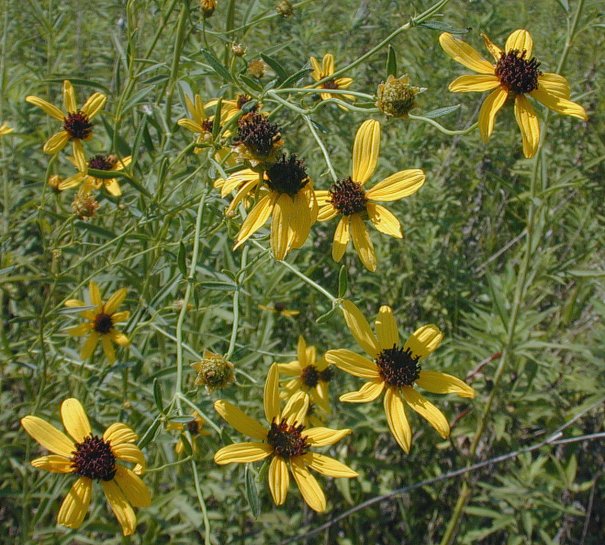Perennials, 90-180+ cm. Internodes (± mid stem) 3-7(-10+) cm. Leaves: petioles 5-45 mm; blades usually 3-foliolate, leaflets usually simple, sometimes ± pinnately lobed, ultimate blades ± lanceolate, 4-9(-12+) cm × (9-)12-35+ mm. Peduncles 2-5+ cm. Calyculi of 5-6 oblong bractlets 1.5-5 mm. Phyllaries 8, ± oblong to lance-oblong, 6-8 mm. Ray laminae 12-22+ mm. Disc florets 40-80+; corollas red-brown to purplish, 5-6 mm. Cypselae obovate to oblong, 4-5(-6) mm. 2n = 26.
Flowering Jul-Sep. Heavy loams, moist sands, along streams, boggy meadows; 100-500 m; Ont., Que.; Ala., Ark., Conn., D.C., Fla., Ga., Ill., Ind., Iowa, Kans., Ky., La., Md., Mass., Mich., Miss., Mo., N.C., Ohio, Okla., Pa., R.I., S.C., Tenn., Tex., Vt., Va., W.Va., Wis.
Frequent in the lake area, where it is usually found in very sandy soil in open woodland and fallow fields, in prairie habitats, and along roadsides. It is rare to local in the southern part of the state, where it is found in small prairie areas or in open woodland in the knobstone area.
[Variety deamii, characterized by pubescent phyllaries and lower leaf surfaces,] has nearly the same distribution as the species, but it is much less frequent. I have had both it and the species under cultivation for more than ten years. In addition to the characters given in the key, the variety may be separated at a distance by its darker green color and earlier flowering period.
[Variety intercedens has glabrous phyllaries and pubescent lower leaf surfaces.] This has been reported from the dune area, and I have a specimen from Whitley County. Doubtless it is rare. I believe this is only a glabrate form of the preceding variety [var. deamii].
Single-stemmed perennial 1-3 m from a short, stout rhizome, usually glabrous and somewhat glaucous; lvs mainly cauline, numerous, on evident petioles 0.5-3 cm, mostly trifoliolate, or the upper entire, the lfls lanceolate or narrowly elliptic, 5-10(-13) cm נ6-25(-30) mm, the terminal one often again divided; heads several or many, the disk to 1 cm wide, yellow, becoming purplish or deep red, its cors 5-toothed; outer bracts ca 8, linear-oblong, obtuse, 2-3 mm, the inner much broader and 2-3 times as long, more acute; rays yellow, 1-2.5 cm; receptacular bracts narrowly linear or linear-clavate; style-appendages cuspidately acute; achenes obovate, 4-7 mm; pappus of a few minute erect bristles, sometimes also with 2 short, upwardly barbed awns; 2n=26. Mostly in moist or wet low places and in woods; Mass. and s. Ont. to Wis., s. to Fla. and Tex. July-Sept.
Gleason, Henry A. & Cronquist, Arthur J. 1991. Manual of vascular plants of northeastern United States and adjacent Canada. lxxv + 910 pp.
©The New York Botanical Garden. All rights reserved. Used by permission.








